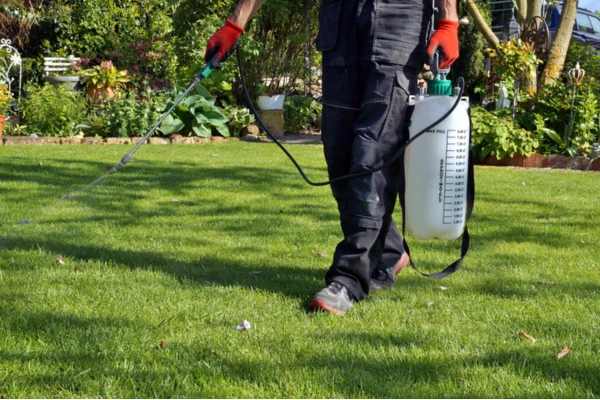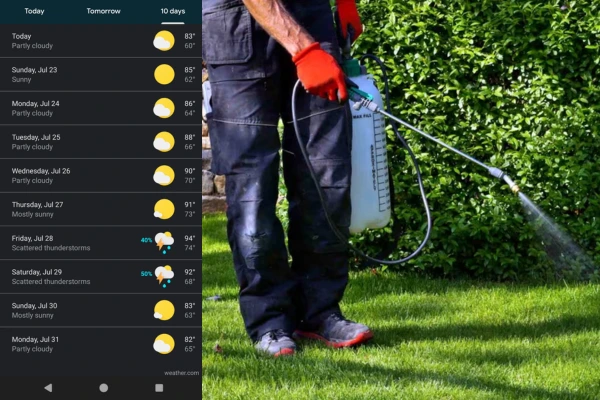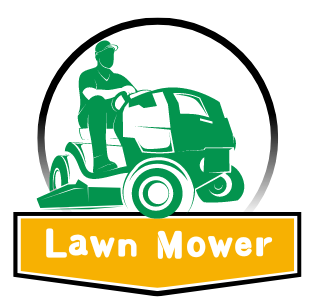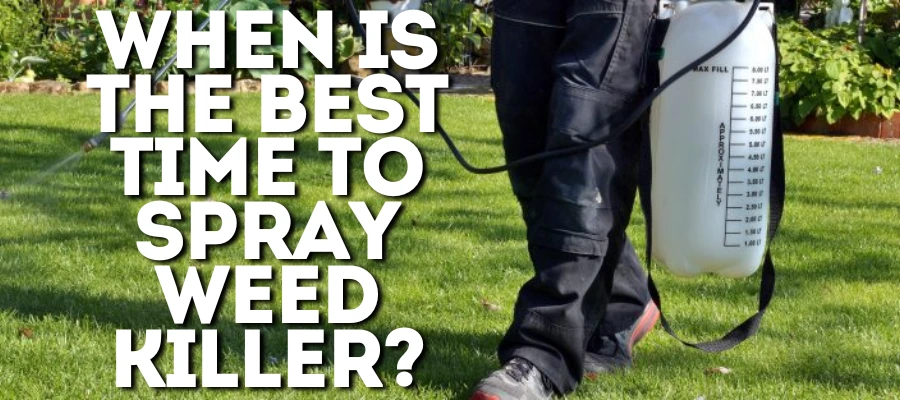Timing is crucial when spraying weed killer, as applying herbicides at the wrong moment can lead to wasted product, unsatisfactory results, or even damage to your plants and lawn.
Whether you’re fighting a stubborn weed invasion or maintaining a healthy garden, knowing when to spray weed killer can make all the difference.
Several factors play into the best time to spray, including the time of day, weather conditions, temperature, and the type of weed killer you’re using. Considering these variables ensures that your weed control efforts are not wasted.
In this guide, we’ll cover everything you need to know to answer the question, “When is the best time to spray weed killer?”
What Is the Best Time of Day to Spray Weed Killer?

The time of day significantly impacts how effective your herbicide application will be. Studies suggest that midday is the optimal time for spraying weed killer, but nighttime can also be effective when daytime spraying isn’t feasible. Here’s a detailed breakdown of the best times of day and how they affect weed killer performance:
Midday (11 AM – 2 PM)
During midday, sunlight is at its peak, and temperatures are higher. This creates ideal conditions for herbicides to be absorbed into weed leaves. Most plants, including weeds, open their stomata (tiny openings on leaves) during the warmest part of the day, allowing the chemicals to penetrate the plant and disrupt its growth. The heat also prevents dew from forming, ensuring the herbicide sticks to the leaves.
Why it Works: Herbicides work by targeting the biological functions within the plant. During midday, the metabolic processes of weeds are in full swing, which means they absorb herbicides more readily. This is especially true for post-emergent herbicides that need to be absorbed through the leaves.
Data Table: Herbicide Absorption by Time of DayTime of DayAbsorption RateEffectivenessMidday85%Most EffectiveNight75%EffectiveMorning55%Least Effective
Night Spraying
Nighttime herbicide applications are often overlooked but can be highly effective. During the night, weeds continue to grow and absorb nutrients from the soil, meaning herbicides applied after sunset can still be effective. Moreover, cooler nighttime temperatures reduce the risk of evaporation, which means the herbicide remains on the weeds longer.
When to Consider Night Spraying: If you live in a region where daytime temperatures are excessively high, or you can’t spray during the day, night spraying may be a good option. Studies suggest that night spraying is more effective than early morning applications because there’s no risk of dew formation that could dilute the herbicide.
Study Example: Research from September 2016 highlighted that nighttime herbicide applications were nearly as effective as midday applications, with minimal differences in weed control effectiveness. Farmers and gardeners who work full-time jobs may find night spraying a convenient and effective alternative.
Morning (6 AM – 9 AM)
Many people mistakenly believe that early morning is a good time to spray weed killer. However, the presence of dew on the leaves can dilute the herbicide, reducing its efficacy. Moreover, plants tend to be less metabolically active in the morning compared to later in the day, meaning they absorb the herbicide more slowly.
Why Morning Isn’t Ideal: Dew can cause the herbicide to run off the leaves, wasting the product. Additionally, cooler temperatures in the morning can slow down plant absorption, which means the herbicide might not work as well.
Evening (5 PM – 8 PM)
If midday spraying isn’t an option, spraying in the early evening can be effective. As temperatures cool and winds die down, herbicides are less likely to evaporate or drift away. However, absorption rates tend to slow down as the sun sets.
Pros and Cons: Evening spraying minimizes evaporation and wind drift, but the plant’s absorption rate isn’t as high as it is during the middle of the day.
Day vs. Night Herbicide Application
A comprehensive study conducted in September 2016 tested weed control effectiveness at various times of day. The researchers found that midday spraying resulted in the best weed control outcomes, followed by night spraying. Morning applications were the least effective due to the presence of dew, which diluted the herbicide and reduced its absorption. The study concluded that when deciding on the best time to spray weed killer, environmental factors like temperature, sunlight, and moisture must be taken into account.
Weather Conditions to Consider When Spraying Weed Killer

Weather has a big impact on how well weed killers work. Spraying in the wrong conditions can make the herbicide less effective. Here are key weather factors to keep in mind:
Temperature
Ideal Range: The best temperature for spraying weed killer is between 60°F and 85°F. In this range, weeds absorb herbicides easily.
Too Hot (90°F+): When it’s over 90°F, weeds slow down to conserve moisture and won’t absorb the weed killer well. High heat can also make the herbicide evaporate quickly.
Too Cold (Below 55°F): In colder temperatures, weeds absorb herbicides more slowly, making them less effective.
Rainfall
Wait for Dry Weather: Rain can wash the herbicide off the plants. It’s best to spray when no rain is expected for at least 24 hours. This gives the herbicide time to be absorbed.
Tip: Check the weather forecast before spraying to avoid wasting your weed killer.
Wind
Avoid Windy Days: High winds can blow the herbicide away from the target area. The ideal wind speed for spraying is less than 10 mph to keep the spray from drifting.
Does Adding Dish Soap to Weed Killer Help?
Many gardeners add dish soap to their herbicide mix to improve its effectiveness. Dish soap acts as a surfactant, which helps the herbicide stick to the leaves of weeds by reducing the surface tension of the liquid. This can improve the penetration of the herbicide, making it more effective at killing weeds.
Why It Works: Herbicides often slide off waxy leaves, but adding a surfactant like dish soap helps the chemical bond to the leaf surface. This increases the amount of herbicide absorbed, leading to better results.
Conclusion
Knowing when to spray weed killer can make a significant difference in your weed control efforts. Midday remains the most effective time for herbicide application, with night spraying serving as a viable alternative. Always consider environmental factors like temperature, rainfall, and wind to ensure the herbicide is applied in optimal conditions. By timing your application correctly, you’ll maximize the herbicide’s effectiveness, save money, and achieve better results in your garden or lawn.

